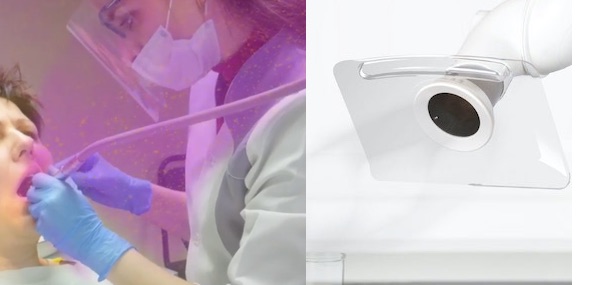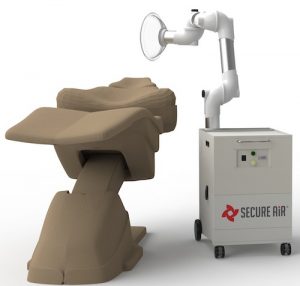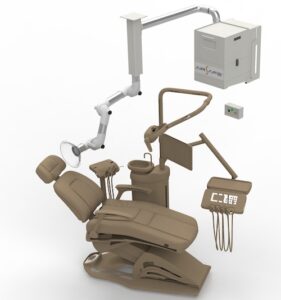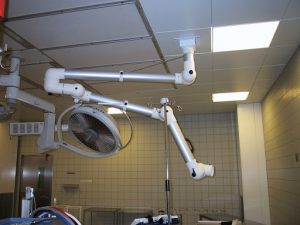
Following the coronavirus emergency, dentists and dental practices must be organized to work in maximum safety in view of phase 2; equip yourself to aspirate the potentially infected aerosol during interventions , before breathing, is certainly , one of the most important measures to be taken.

Following the appearance of the coronavirus, the problem of controlling the risk of infection caused by the aerosol produced by the turbines used for many therapeutic maneuvers in the dental field has returned to the foreground for dentists. It is known that for those who work on the patient, be it dentistry or hygienist, there are a number of biological risks that arise from so-called “aerosol pollution” or derived from the use of rotating and ultrasonic instruments that remove solid material from the operating field, thus creating a potentially infected and contaminating mist.
Technically, an aerosol extractor is needed to prevent its spread because it spreads, through the cooling water and the air coming out of the turbines, a cloud of more than one meter in diameter containing, among other compounds, biological material, viruses, and bacteria.
The most topical case is definitely the one related to the COVID-19 virus which, as we know, has recently been identified several times in the saliva of infected patients. This saliva is known to play a decisive role in human-to-human transmission, and dentists with other caregivers may unknowingly operate on patients infected but not yet diagnosed with COVID-19, or those who are asymptomatic. Inhalation of airborne particles and aerosols produced during dental procedures on patients with COVID-19 is therefore a very risky situation to which dentists are directly exposed. It is therefore crucial that dentists perfect preventive strategies to avoid COVID-19 infection, focusing on patient placement, hand hygiene, and all personal protective equipment (PPE).
Considering therefore that the staff is already amply equipped of devices DPI, that is of a protection “passive” towards the biological risk, in order to ulteriorly reduce this risk of infection for the professional it becomes necessary to pass to a solution “active” means that it removes or reduces the aerosol before it reaches the PPE and potentially the respiratory tract. The technique is already used in industrial contexts to protect the respiratory tract of the operator and widely indicated by the legislative guidelines (Dgls 81/2008) and by the most efficient techniques of dust and fumes abatement. It is necessary to draw as close as possible to the source, thus avoiding the dispersion of the aerosol inside the laboratory, when then it becomes almost impossible to knock it down.
Thanks to this technology, the aerosol extractor with the mobile suction arm positioned 20-30 cm from the patient’s mouth (a distance that allows the necessary movements) is capable of conveying the dangerous volatile processing residue away from the operating area to reduce as much as possible the risk of infection of operators. The aspirated aerosol is then filtered with equipment suitable for the abatement of wet mists with final efficiency HEPA H14 99.9% and then returned to a purified environment, or conveyed outside depending on logistical and plant requirements.
There are already several products on the market dedicated to the suction of aerosols or fumes produced during medical operations. However, in the specific case of the risk Covid-19, it is of fundamental importance to technically address the suction and filtration in a more complete way, analyzing thoroughly all the components of this polluting “cloud”.
It is definitely not recommended to use extractors not specifically designed for this application. Below we list three solutions that vary according to operational needs and available working spaces.
|
Mobile extractor on wheels with self-supporting arm, with pre-muffling of the wet part aspirated, absolute filtration HEPA H14 99,995% and arm with transparent hood with circular section. Indicative dimensions mm 510x660x780 H (without arm) Important requirement: the suction arm to ensure the nominal flow rate of 400 mc/h must have the pipes diameter 100mm otherwise the flow rate will be reduced and the noise will be high. Pros: Very flexible solution that allows to move the purifier in different working rooms Cons: additional footprint to be added to the ground around the operating area Click here for all the information about the mobile purifier. |
 |
|
Wall or ceiling extractor with pre-glare of the aspirated wet part, absolute filtration HEPA H14 99,995% and connection kit to self-supporting suction arm fixed to the ceiling or wall, with transparent hood with circular section. Dimensions indicative mm 600x700x900 H (without arm) Important requirement: the suction arm, to ensure the nominal flow rate of 400 mc/h, must have the pipes diameter 100mm otherwise the flow rate will be low and the noise high. Pros: No footprint on the ground, the arm “drops” from the ceiling or is extended from the wall near the operating area. Cons: Installation required for wall mounting and electrical connection to the network |
 |
| Centralized plant for aerosol aspiration
Solution intended for contexts where it is desired to aspirate from several units conveying in a single central suction and purification. Technically each workstation is equipped with a suction arm fixed to the ceiling, then connected to a single central suction and purification with damp condensate abatement and absolute filtration HEPA H14 99,995% Advantages: no extractor inside the operating area, ideal for designing new studios Cons: hardly applicable in retrofit, requires steps in false ceiling, masonry and important plant. |
 |
There are already some systems on the market that, however, have not been designed for the treatment of aerosol and in addition to not solving the problem of the wet part already technically addressed in this article, often propose additional filtration with UV – UVG or with activated carbon panels.
You have to pay a lot of attention to these technical characteristics because in addition to being ineffective can also be dangerous, here are the specific info:
Our technical staff available for collect needs, request quotes or give technical advice, simply fill in the form at the bottom of the page and you will be contacted.
Links e credits
The effect of aerosol in the dental practice – Prof. Abati
Covid-19 and dentistry, resource analysis
Fill in the form below to request a quote by email, agree on special conditions, or technical clarifications